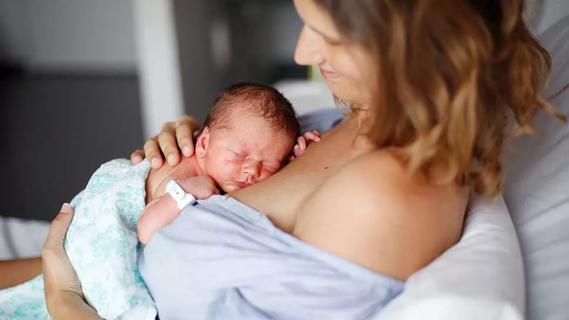Crossed eyes in a newborn are fairly common, typically harmless and usually go away

There’s nothing like gazing at your newborn’s little face. There’s so much curiosity in their eyes. But should you be concerned if those beautiful eyes cross, wander or move in different directions? Could it be a sign that something’s wrong with your baby’s eyes or vision?
Advertisement
Cleveland Clinic is a non-profit academic medical center. Advertising on our site helps support our mission. We do not endorse non-Cleveland Clinic products or services. Policy
Pediatrician Rajyalakshmi Rambhatla, MD, explains why many newborns appear to have crossed eyes — and when to be concerned about it.
It’s not unusual for a newborn’s eyes to move out of sync from time to time. You might see their eyes cross, move in different directions or float to the sides for a few seconds. There are a couple of reasons newborns have these unusual eye movements — and they’re not likely to be related to long-term vision problems.
Before your baby entered the world, they spent all their time in darkness. They didn’t need to use their vision in the uterus, so their eyes didn’t get practice moving and fixating on objects. Like any beginner with a new skill, your newborn’s eyes need time to get the hang of things.
“A baby’s vision isn’t fully developed when they’re born,” explains Dr. Rambhatla. “Their eyes are learning to focus and the muscles that move their eyes aren’t fully coordinated. These abilities develop rapidly in your baby’s first few months.”
As your baby’s eyes adjust to the outside world, it’s normal for them to wander outward or cross occasionally. Those little peepers are just finding their rhythm. Around 4 months of age, babies can usually move their eyes together without issues and this is often when you stop seeing crossed eyes.
Advertisement
Sometimes, a newborn’s “crossed eyes” aren’t crossed at all. It could be that the shape of their face during infancy makes their eyes look like they’re turning inward, which healthcare providers call pseudostrabismus.
“Many babies have a wider nose and small folds of eyelid skin that cover the inner corners of their eyes,” clarifies Dr. Rambhatla. “When you can’t see the inner corner of their eyes, your baby may look a little cross-eyed. But as your baby grows, these skin folds become less prominent, and their eyes will appear straight.”
Crossed eyes happen from time to time in many newborns. But in some cases, wandering or crossed eyes can be a sign of an eye condition like strabismus (eye misalignment).
“Strabismus is a common eye condition in children and it’s treatable,” says Dr. Rambhatla. Talk to your pediatrician if your baby’s eyes:
It’s normal for a newborn to experience crossed eyes occasionally. Still, don’t be afraid to raise any concerns about your baby’s eyes with their healthcare provider.
“Your pediatrician is here to listen to any questions and concerns you have about your baby’s health,” reassures Dr. Rambhatla. “And if a baby does have an eye condition, early diagnosis and treatment will give them the best chance of healthy vision now and for years to come.”
Advertisement
Learn more about our editorial process.
Advertisement

Gripe water isn’t regulated by the FDA, and research doesn’t support its use

Jaundice that’s present at birth or lasts more than a week should be evaluated by a pediatrician

When tight neck muscles give your newborn a head tilt, these gentle exercises can go a long way

Neonatal opioid withdrawal syndrome, or NOWS, can develop when a fetus is exposed to opioids, nonmedical drugs or even some prescription drugs during pregnancy

Most parents report an improvement in breastfeeding, but there’s a chance the procedure won’t solve the issue

All babies go through a perfectly normal peeling phase in the first couple weeks

Moisturizer, a daily bath and some gentle nudging can help

Dietary and behavioral changes can help get things moving again

The best parenting style balances enforcing rules and showing plenty of love

Tips include cutting back on sugar, focusing on exercise and managing stress

It can be harder to let go when you’ve invested time, energy and emotions — but it might be the healthier choice long term